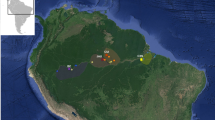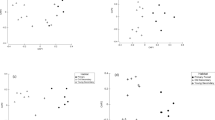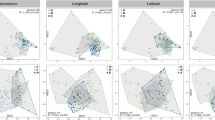Abstract
High animal and plant richness in tropical rainforest communities has long intrigued naturalists. It is unknown if similar hyperdiversity patterns are reflected at the microbial scale with unicellular eukaryotes (protists). Here we show, using environmental metabarcoding of soil samples and a phylogeny-aware cleaning step, that protist communities in Neotropical rainforests are hyperdiverse and dominated by the parasitic Apicomplexa, which infect arthropods and other animals. These host-specific parasites potentially contribute to the high animal diversity in the forests by reducing population growth in a density-dependent manner. By contrast, too few operational taxonomic units (OTUs) of Oomycota were found to broadly drive high tropical tree diversity in a host-specific manner under the Janzen-Connell model. Extremely high OTU diversity and high heterogeneity between samples within the same forests suggest that protists, not arthropods, are the most diverse eukaryotes in tropical rainforests. Our data show that protists play a large role in tropical terrestrial ecosystems long viewed as being dominated by macroorganisms.
This is a preview of subscription content, access via your institution
Access options
Access Nature and 54 other Nature Portfolio journals
Get Nature+, our best-value online-access subscription
$29.99 / 30 days
cancel any time
Subscribe to this journal
Receive 12 digital issues and online access to articles
$119.00 per year
only $9.92 per issue
Buy this article
- Purchase on Springer Link
- Instant access to full article PDF
Prices may be subject to local taxes which are calculated during checkout



Similar content being viewed by others
References
von Humboldt, A. & Bonpland, A. Personal Narrative of Travels to the Equinoctial Regions of the New Continent, During the Years 1799–1804 (Longman, Hurst, Rees, Orme & Brown, 1814–1829).
Valencia, R., Balslev, H. & Paz Y Miño, G. High tree alpha-diversity in Amazonian Ecuador. Biodivers. Conserv. 3, 21–28 (1994).
Wilson, E. O. The arboreal ant fauna of Peruvian Amazon forests: a first assessment. Biotropica 19, 245–251 (1987).
Janzen, D. H. Herbivores and the number of tree species in tropical forests. Am. Nat. 104, 501–528 (1970).
Connell, J. H. in Dynamics of Population (eds Den Boer, P. J. & Gradwell, G. R. ) 298–392 (Wageningen, 1971).
Bagchi, R. et al. Pathogens and insect herbivores drive rainforest plant diversity and composition. Nature 506, 85–88 (2014).
Terborgh, J. Enemies maintain hyperdiverse tropical forests. Am. Nat. 107, 481–501 (2012).
Basset, Y. et al. Arthropod diversity in a tropical forest. Science 338, 1481–1484 (2012).
Erwin, T. L. Tropical forests, their richness in Coleoptera and other arthropod species. Coleopts. Bull. 36, 74–75 (1982).
Pawlowski, J. et al. CBOL Protist Working Group: barcoding eukaryotic richness beyond the animal, plant, and fungal kingdoms. PLoS Biol. 10, e1001419 (2012).
de Vargas, C. et al. Eukaryotic plankton diversity in the sunlit ocean. Science 348, 1261605 (2015).
Guillou, L. et al. The Protist Ribosomal Reference database (PR2): a catalog of unicellular eukaryote small sub-unit rRNA sequences with curated taxonomy. Nucleic Acids Res. 41, D597–D604 (2013).
Stoeck, T. et al. Multiple marker parallel tag environmental DNA sequencing reveals a highly complex eukaryotic community in marine anoxic water. Mol. Ecol. 19, 21–31 (2010).
Berger, S. A., Krompass, D. & Stamatakis, A. Performance, accuracy, and web server for evolutionary placement of short sequence reads under maximum likelihood. Syst. Biol. 60, 291–302 (2011).
Stamatakis, A. RAxML version 8: a tool for phylogenetic analysis and post-analysis of large phylogenies. Bioinformatics 30, 1312–1313 (2014).
Mahé, F., Rognes, T., Quince, C., de Vargas, C. & Dunthorn, M. Swarm v2: highly-scalable and high-resolution amplicon clustering. PeerJ 3, e1761 (2015).
Dunthorn, M. et al. Placing environmental next-generation sequencing amplicons from microbial eukaryotes into a phylogenetic context. Mol. Biol. Evol. 31, 993–1009 (2014).
Desportes, I. & Schrével, J. Treatise on Zoology—Anatomy, Taxonomy, Biology: The Gregarines Vols 1 & 2 (Brill, 2013).
Perkins, F. O., Barta, J. R., Clopton, R. E., Peirce, M. A. & Upton, S. J. in An Illustrated Giude to the Protozoa 2nd edn (eds Lee, J. J., Leedale, G. F. & Bradbury, P. ) 190–369 (Society of Protozoologists, 2002).
Adl, S. M. et al. The revised classification of eukaryotes. J. Eukaryot. Microbiol. 59, 429–493 (2012).
Dawson, S. C. & Pace, N. R. Novel kingdom-level eukaryotic diversity in anoxic environments. Proc. Natl Acad. Sci. USA 99, 8324–8329 (2002).
Edvardsen, B., Egge, E. & Vaulot, D. Diversity and distribution of haptophytes revealed by environmental sequencing and metabarcoding — a review. Perspec. Phycol. 3, 77–91 (2016).
Elbert, W. et al. Contribution of cryptogamic covers to the global cycles of carbon and nitrogen. Nat. Geosci. 5, 459–462 (2012).
Gentry, A. H. Four Neotropical Rainforests (Yale Univ. Press, 1991).
Hu, S. K. et al. Protistan diversity and activity inferred from RNA and DNA at a coastal ocean site in the eastern North Pacific. FEMS Microbiol. Ecol. 92, fiw050 (2016).
Filker, S., Gimmler, A., Dunthorn, M., Mahé, F. & Stoeck, T. Deep sequencing uncovers high and substantial novel diversity in protistan plankton of solar saltern ponds. Extremophiles 19, 283–295 (2015).
Forster, D. et al. Benthic protists: the under-charted majority. FEMS Microbiol. Ecol. 92, fiw120 (2016).
Logares, R. et al. Patterns of rare and abundant marine microbial eukaryotes. Curr. Biol. 24, 813–821 (2014).
Richards, T. A. et al. Molecular diversity and distribution of marine fungi across 130 European environmental samples. Proc. R. Soc. B 282, 20152243 (2015).
Adl, S. M., Habura, A. & Eglit, Y. Amplification primers of SSU rDNA for soil protists. Soil Biol. Biochem. 69, 328–342 (2014).
Hu, S. K. et al. Estimating protistan diversity using high-throughput sequencing. J. Eukaryot. Microbiol. 62, 688–693 (2015).
Lentendu, G. et al. Effects of long-term differential fertilization on eukaryotic microbial communities in an arable soil: a multiple barcoding approach. Mol. Ecol. 23, 3341–3355 (2014).
Forster, D., Dunthorn, M., Stoeck, T. & Mahé, F. Comparison of three clustering approaches for detecting novel environmental microbial diversity. PeerJ 4, e1692 (2016).
Adl, S. & Gupta, V. V. S. R. Protists in soil ecology and forest nutrient cycling. Can. J. For. Res. 36, 1805–1817 (2006).
Bates, S. T. et al. Global biogeography of highly diverse protistan communities in soil. ISME J. 7, 652–659 (2013).
Dumack, K., Müller, M. E. H. & Bonkowski, M. Description of Lecythium terrestris sp. nov. (Chlamydophryidae, Cercozoa), a soil dwelling protist feeding on fungi and algae. Protist 167, 93–105 (2016).
Dupont, A., Griffiths, R. I., Bell, T. & Bass, D. Differences in soil micro-eukaryotic communities over soil pH gradients are strongly driven by parasites and saprotrophs. Environ. Microbiol. 18, 2010–2024 (2016).
Geisen, S. et al. Metatranscriptomic census of active protists in soils. ISME J. 9, 2178–2190 (2015).
Grossmann, L. et al. Protistan community analysis: key findings of a large-scale molecular sampling. ISME J. 10, 2269–2279 (2016).
Foissner, W. Colpodea (Cillophora) (Protozoenfauna Vol. 4/1, Gustav Fischer Verlag, 1993).
Mitchell, E. A. D. Pack hunting by minute soil testate amoebae: nematode hell is a naturalist’s paradise. Environ. Microbiol. 17, 4145–4147 (2015).
Ellis, V. A. et al. Local host specialization, host-switching, and dispersal shape the regional distributions of avian haemosporidian parasites. Proc. Natl Acad. Sci. USA 112, 11294–11299 (2015).
Rueckert, S., Villette, P. M. & Leander, B. S. Species boundaries in gregarine apicomplexan parasites: a case study-comparison of morphometric and molecular variability in Lecudina cf. tuzetae (Eugregarinorida, Lecudinidae). J. Eukaryot. Microbiol. 58, 275–283 (2011).
Asghar, M. et al. Hidden costs of infection: chronic malaria accelerates telomere degradation and senescence in wild birds. Science 347, 436–438 (2015).
Bouwma, A. M., Howard, K. J. & Jeanne, R. L. Parasitism in a social wasp: effect of gregarines on foraging behavior, colony productivity, and adult mortality. Behav. Ecol. Sociobiol. 59, 222–233 (2005).
Freckleton, R. P. & Lewis, O. T. Pathogens, density dependence and the coexistence of tropical trees. Proc. R. Soc. B 273, 2909–2916 (2006).
Farrell, B. D. “Inordinate fondness” explained: Why are there so many beetles? Science 281, 555–559 (1998).
Knoll, A. H. Paleobiological perspectives on early eukaryotic evolution. Cold Spring Harb. Perspect. Biol. 6, a016121 (2014).
Tedersoo, L. et al. Global diversity and geography of soil fungi. Science 346, 1256688 (2014).
Orsi, W., Biddle, J. F. & Edgcomb, V. Deep sequencing of subseafloor eukaryotic rRNA reveals active fungi across marine subsurface provinces. PLoS ONE 8, e56335 (2013).
Pawlowski, J., Esling, P., Lejzerowicz, F., Cedhagen, T. & Wilding, T. Environmental monitoring through protist next-generation sequencing metabarcoding: assessing the impact of fish farming on benthic foraminifera communities. Mol. Ecol. Res. 14, 1129–1140 (2014).
Mahé, F. et al. Comparing high-throughput platforms for sequencing the hyper-variable V4 region in environmental eukaryotic diversity surveys. J. Eukaryot. Microbiol. 62, 338–345 (2015).
Lara, E., Berney, C., Harms, H. & Chatzinotas, A. Cultivation-independent analysis reveals a shift in ciliate 18S rRNA gene diversity in a polycyclic aromatic hydrocarbon-polluted soil. FEMS Microbiol. Ecol. 62, 365–373 (2007).
Magoč, T. & Salzberg, S. L. FLASH: fast length adjustment of short reads to improve genome assemblies. Bioinformatics 27, 2957–2963 (2011).
Zhang, J., Kobert, K., Flouri, T. & Stamatakis, A. PEAR: a fast and accurate Illumina Paired-End reAd mergeR. Bioinformatics 30, 614–620 (2014).
Massana, R. et al. Marine protist diversity in European coastal waters and sediments as revealed by high-throughput sequencing. Environ. Microbiol. 17, 4035–4049 (2015).
Amaral-Zettler, L. A., McCliment, E. A., Ducklow, H. W. & Huse, S. M. A method for studying protistian diversity using massively parallel sequencing of V9 hypervariable region of small-subunit ribosomal RNA genes. PLoS ONE 4, 7 (2009).
Martin, M. Cutadapt removes adapter sequences from high-throughput sequencing reads. EMBnet.journal 17, 10–12 (2011).
Rognes, T., Flouri, T., Nichols, B., Quince, C. & Mahé, F. VSEARCH: a versatile open source tool for metagenomics. PeerJ 4, e2584 (2016).
Mahé, F. Stampa: sequence taxonomic assignment by massive pairwise alignments. GitHubhttps://github.com/frederic-mahe/stampa (2016).
Burki, F. The eukaryotic tree of life from a global phylogenomic perspective. Cold Spring Harb. Perspect Biol. 6, a016147 (2014).
del Campo, J. et al. The others: our biased perspective of eukaryotic genomes. Trends Ecol. Evol. 29, 252–259 (2014).
Barta, J. R., Ogedengbe, J. D., Martin, D. S. & Smith, T. G. Phylogenetic position of the adeleorinid coccidia (Myzozoa, Apicomplexa, Coccidia, Eucoccidiorida, Adeleorina) inferred using 18S rDNA sequences. J. Eukaryot. Microbiol. 59, 171–180 (2012).
Bass, D. & Cavalier-Smith, T. Phylum-specific environmental DNA analysis reveals remarkably high global biodiversity of Cercozoa (Protozoa). Int. J. Syst. Evol. Microbiol. 54, 2393–2404 (2004).
Gomez, F., López-Garcia, P., Nowaczyk, A. & Moreira, D. The crustacean parasites Ellobiopsis Caullery, 1910 and Thalassomyces Niezabitowski, 1913 form a monophyletic divergent clade within the Alveolata. Syst. Parasitol. 74, 65–74 (2009).
Rueckert, S. & Leander, B. S. Molecular phylogeny and surface morphology of marine archigregarines (Apicomplexa), Selenidium spp., Filipodium phascolosomae n. sp., and Platyproteum n. g. and comb. from North-Eastern Pacific peanut worms (Sipuncula). J. Eukaryot. Microbiol. 56, 428–439 (2009).
Rueckert, S., Chantangsi, C. & Leander, B. S. Molecular systematics of marine gregarines (Apicomplexa) from North-eastern Pacific polychaetes and nemerteans, with descriptions of three novel species: Lecudina phyllochaetopteri sp. nov., Difficilina tubulani sp. nov. and Difficilina paranemertis sp. nov. Int. J. Syst. Evol. Microbiol. 60, 2681–2690 (2010).
Slapeta, J. & Linares, M. C. Combined amplicon pyrosequencing assays reveal presence of the apicomplexan “type-N” (cf. Gemmocystis cylindrus) and Chromera velia on the Great Barrier Reef, Australia. PLoS ONE 8, e76095 (2013).
Wakeman, K. C. & Leander, B. S. Molecular phylogeny of Pacific Archigregarines (Apicomplexa), including descriptions of Veloxidium leptosynaptae n. gen., n. sp., from the sea cucumber Leptosynapta clarki (Echinodermata), and two new species of Selenidium. J. Eukaryot. Microbiol. 59, 232–245 (2012).
Berger, S. A. & Stamatakis, A. Aligning short reads to reference alignments and trees. Bioinformatics 27, 2068–2075 (2011).
Czech, L. & Stamatakis, A. Genesis. A toolkit for working with phylogenetic data. GitHubhttps://github.com/lczech/genesis (2016).
Egge, E., Eikrem, W. & Edvardsen, B. Deep-branching novel lineages and high diversity of haptophytes in the Skagerrak (Norway) uncovered by 454 pyrosequencing. J. Eukaryot. Microbiol. 62, 121–140 (2015).
Shalchian-Tabrizi, K., Reier-Røberg, K., Ree, D. K., Klaveness, D. & Bråte, J. Marine-freshwater colonizations of haptophytes inferred from phylogeny of environmental 18S rDNA sequences. J. Eukaryot. Microbiol. 58, 315–318 (2011).
Katoh, K., Misawa, K., Kuma, K. & Miyata, T. MAFFT: a novel method for rapid multiple sequence alignment based on fast Fourier transform. Nucleic Acids Res. 30, 3059–3066 (2002).
Altschul, S. F. et al. Gapped BLAST and PSI-BLAST: a new generation of protein database search programs. Nucleic Acids Res. 25, 3389–3402 (1997).
Lara, E. & Belbahri, L. SSU rRNA reveals major trends in oomycete evolution. Fungal Divers. 49, 93–100 (2011).
Willis, A. & Bunge, J. Estimating diversity via frequency ratios. Biometrics 71, 1042–1049 (2015).
Bunge, J. et al. Estimating population diversity with CatchAll. Bioinformatics 28, 1045–1047 (2012).
Oksanen, J. et al. vegan: Community Ecology Package. R package version 2.0-7 (2013).
R Core Team R: A Language and Environment for Statistical Computing (R Foundation for Statistical Computing, 2014).
Wickham, H. gplot2: Elegant Graphics for Data Analysis (Springer, 2009).
Lane, D. J. in Nucleic Acids Techniques in Bacterial Systematics (eds Stackebrandt, E. & Goodfellow, M. ) 115–147 (John Wiley & Sons, 1991).
Medlin, L., Elwood, H. J., Stickel, S. & Sogin, M. L. The characterization of enzymatically amplified eukaryotes 16S-like ribosomal RNA coding regions. Gene 71, 491–500 (1988).
Zhu, F., Massana, R., Not, F., Marie, D. & Vaulot, D. Mapping of picoeucaryotes in marine ecosystems with quantitative PCR of the 18S rRNA gene. FEMS Microbiol. Ecol. 52, 79–92 (2005).
Acknowledgements
We thank T. Stoeck, L. Katz, H. Kauserud, O. T. Lewis and D. Montagnes for helpful comments. Funding primarily came from: a Deutsche Forschungsgemeinschaft grant DU1319/1-1 to M.D.; the Klaus Tschira Foundation to L.C., A.S and A.K; and the French Government’s ‘Investissements d’Avenir’ program OCEANOMICS (ANR-11-BTBR-0008) to C.d.V., C.B. and S.R. Funding also came from: the Natural Environment Research Council grants NE/H000887/1 and NE/H009426/1 to D.B.; the National Science Foundation’s International Research Fellowship Program (OISE-1012703) and the Smithsonian Tropical Research Institute’s Fellowship program to J.M.; the Swiss National Science Foundation (310003A 143960); and the Swiss Federal Office for the Environment and Swiss National Science Foundation to E.L. and E.A.D.M. The authors gratefully acknowledge the Gauss Centre for Supercomputing e.V. (www.gauss-centre.eu) for funding this project by providing computing time on the GCS Supercomputer SuperMUC at the Leibniz Supercomputing Centre (www.lrz.de).
Author information
Authors and Affiliations
Contributions
F.M. and M.D. conceived the project. F.M., C.d.V., J.M., T.S., S.R. and M.D. collected the samples. Sequencing was carried out by F.M., T.S., I.T., S.R and M.D. Data analysis was done by F.M., D.B., L.C., A.S., E.L., D.S., J.B., S.S., I.T., C.B., A.K., E.E. and M.D. The first draft of the manuscript was written by F.M., C.d.V., D.B., L.C., A.S. and M.D., and all authors contributed to discussing the results and editing the manuscript.
Corresponding author
Ethics declarations
Competing interests
The authors declare no competing financial interests.
Supplementary information
Supplementary Information
Supplementary Methods, Supplementary References, Supplementary Figures 1–16, Supplementary Tables 1–3. (PDF 3214 kb)
Supplementary Code 1
Main computer code and sampling information. (XML 692 kb)
Supplementary Code 2
Additional computer code for phylogenetic placements. (HTML 896 kb)
Supplementary Data 1
GenBank references used in eukaryotic reference tree. (TXT 2380 kb)
Supplementary Data 2
GenBank accession numbers and clade assignments for eukaryotic reference tree. (XLSX 23 kb)
Supplementary Data 3
GenBank references used in Alveolata reference tree. (TXT 441 kb)
Supplementary Data 4
GenBank accession numbers and clade assignments for Alveolata reference tree. (XLSX 15 kb)
Supplementary Data 5
Comparison of constrained and unconstrained phylogenetic placements on the eukaryotic reference tree. (XLSX 27 kb)
Supplementary Data 6
Comparison of constrained and unconstrained phylogenetic placements on the Alveolata reference tree. (XLSX 25 kb)
Rights and permissions
About this article
Cite this article
Mahé, F., de Vargas, C., Bass, D. et al. Parasites dominate hyperdiverse soil protist communities in Neotropical rainforests. Nat Ecol Evol 1, 0091 (2017). https://doi.org/10.1038/s41559-017-0091
Received:
Accepted:
Published:
DOI: https://doi.org/10.1038/s41559-017-0091
This article is cited by
-
Ciliate diversity in rodrigo de freitas lagoon (Rio de Janeiro, Brazil) from an integrative standpoint
Brazilian Journal of Microbiology (2024)
-
Assembly processes and functional diversity of marine protists and their rare biosphere
Environmental Microbiome (2023)
-
Taxonomic composition, community structure and molecular novelty of microeukaryotes in a temperate oligomesotrophic lake as revealed by metabarcoding
Scientific Reports (2023)
-
Beyond the limits of the unassigned protist microbiome: inferring large-scale spatio-temporal patterns of Syndiniales marine parasites
ISME Communications (2023)
-
Global perspective of environmental distribution and diversity of Perkinsea (Alveolata) explored by a meta-analysis of eDNA surveys
Scientific Reports (2023)



